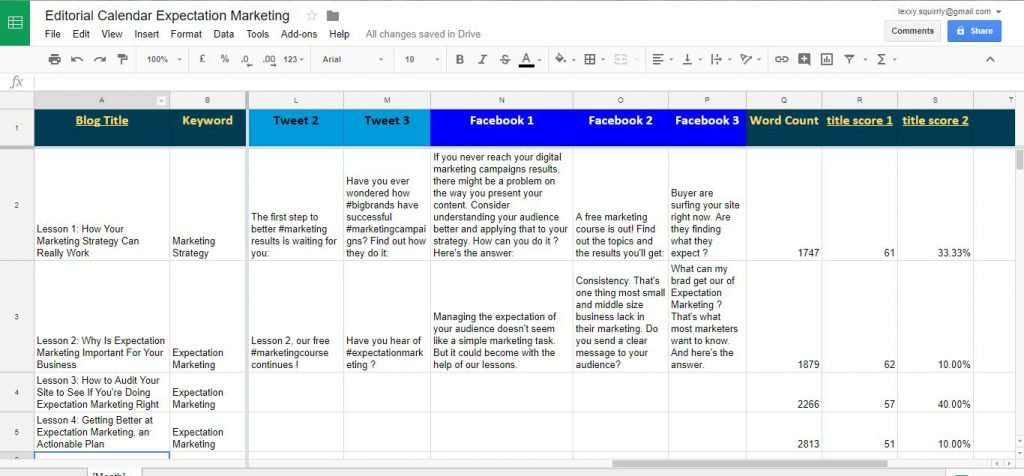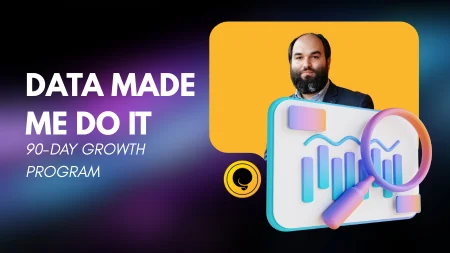It’s all cute and sweet to talk about how this strategy works and what you’ll get after you apply Expectation Marketing but let’s get hustling.
In the last lesson, we’ve given you a helping hand to audit your current plan. You now know if you have the key elements of the strategy. If you haven’t done the audit yet, make sure to evaluate your site first.

In this article, we’ll focus on your options for how to get started. We’ll also go through each element of the audit and tell you which actions you should be taking.
I Want Expectation Marketing, and I Want It Now
If you agree with the above-mentioned statement that’s awesome! We’re here to help.
Depending on how fast you want to see results with your marketing, you can choose a different path. You have 3 options in starting with this strategy:
- DIY. We’ll offer you some guidelines in these lessons and how you can get started with this strategy. And from there on you will apply it as you see fit. But you’ll need help with creating the whole content, targeting it right, promoting it, and applying it on your own. Of course, this is the longest route but probably the most adventurous.
- Use Our Book As A Strategy Plan. If the guidelines in our articles don’t answer all your questions, you can also pre-order our ebook “Expectation Marketing: The New Marketing System that Redefines Trust for Digital Brands”. It’s got great case studies, breakdowns, and file templates you can use in your strategy. You and your team will still have to create targeted content and distribute it in order to grow your brand but you’ll have more information to guide you through the process. It will be a shorter journey once you get access to our marketing kit.
- Start working with us. The last option is to let us do all the hard work. We’ll come up with topics for your audience, write the articles, and if you’re interested even create and schedule your social media posts. We offer all of these as services of our agency, so you can hire us at any point. This will be your shortest path to apply Expectation Marketing.
Now you’ll have to make your choice between the 3 options. For those of you who are interested in applying it yourself, we’re starting the lesson. I’ll give you an in-depth starting point for all the aspects you might need to take care of.
Do It Yourself, But Involve The Whole Team
If you’re a courageous marketer and want to apply this technique, I’m really thrilled for you. Keep in mind that the core principle of Expectation Marketing is consistency. This means you have to create content each week for all your sites and social media profiles.

It can be done if you have a clear structure and a team behind you. The first step was to evaluate your site, and you’ve done that (hopefully) in the previous lesson. Now you know what aspects you need focus on.
To make sure I don’t miss anything I will present each point on its own. Feel free to scroll and find the topic you want to focus on.
Brand Information
If you don’t have this on each page of your site, you need to consider where to add it. The easiest way is to include it in one of the elements that appear on each page.
For example, you should have a menu bar that is the same on all pages. You can include your brand, name, and tagline, on the left or above the bar, similar to a Social Media cover.
As far as the Contact information goes the classic place to add it is in the footer of the page. But that’s not the only option you have. The Grable Group site has tried something different that helps their strategy a lot.

By adding it in the top banner of the page or on the side, you have more chances people will actually see it, which means more visitors will contact you.
Another aspect we stressed upon in the Audit was the short description. In Expectation Marketing it is important for new visitors to understand what your brand is all about.
Make sure the short description, on the Home Page, isn’t too vague or subtle. I’ve seen brands that focus their story on emotions and abstract concepts.
It’s ok to do that in a Tagline or a Motto, but leave the short description as descriptive as possible.
Contact Information
Start by creating a list of all the Communication channels you have. I am thinking of emails, phone numbers, and even social media profiles where you answer quickly to your audience.
Many companies offer support even on Facebook Messenger. Squirrly is one of them.

After you have the full list, consider where you should add them to your site for them to be readily available. The standard answers would start with the page footer and the contact page. But you can also be creative with them.
You can add a particular contact channel where you are presenting it. For example, if you have a Sales Team page, put the Sales contact info there as well.
It’s better to have this information everywhere. Much better than the visitors on your site never finding it.
Written Content
This element is one of Expectation Marketing’s most time-consuming parts. If you don’t have the resources to commit to this strategy right away, contact our agency to help you out.

If you don’t already have a blog on your site, make sure to set one up. If you have a WordPress site that’s easy to do.
Just make sure the theme you have on the site looks good for post type pages. Then create at least one blog category that will be shown on your site.
The real tricky part of Blogging is posting frequently. As I’ve mentioned in the previous lesson, posting at least once a week is a good frequency. But in order to keep this up, you need to get organized.
In our ebook, we offer a clear step by step model and an Editorial Calendar Spread Sheet. Here, I will show you how the structure of the Editorial Calendar we recommend looks like. We’ll also explain the process required to use it to its full potential.
These best practices come after a long period (2014 to 2017) and after creating content for over 100 companies.

In Expectation Marketing, you need an editorial calendar that has all the information in one place, but that isn’t too cramped with info. That way you can stay on top of your strategy in one single file. The strategy works best if you include one sheet in the Editorial Calendar for each month’s publishing. That way you’ll only have 4-5 articles to look at.
The first columns of the editorial calendar are the “Blog title” and the “Keyword.” To make filling out the editorial easier, we added a drop-down menu for the “Writer” and “Status” columns. The stages of the content creation process in Expectation Marketing are:
- Chosen topic (or chosen pitch)
- Research
- Writing
- QA (Quality Assurance)
- Proofreading
- Done
- Scheduled
- Published
The method we recommend is for each member of your team to come up with 25 possible topics for articles on your site. Gather them all in one place. Then the person who is responsible for the strategy should choose the best items.
Add all of the selected topics in your editorial calendar and change the status to “Chosen topic“. This is the moment when you should add the “Publishing dates” for each article.
The date will help your team have a timeline for creating the posts. We recommend you start one month in advance. That means that at the beginning of this month, you’ll choose the topics for all of next month’s slots. (open dates when you’d like to publish)
When someone in your team wants to start creating an article, they will select their name in the “Writer” column. They will also change the status to “Research“. In order for each article to be useful to your audience, you’ll have to do some preliminary research before starting to write the article.

Then the author will start writing the article. They will do it in the back-end of your site and a draft link for the article will be created. This will be copied in the “Temporary link” column and the status of the article will be changed to “Writing“.
After the article has been written, the author will change the status to “QA.” That means your editor can start the Quality Assurance process. They will write all notes regarding changes to the article in the “Editor’s Notes” column.
If there are changes to be made, the post’s status will be switched back to “Writing“, and the Author will implement the changes. Once the article is ready, it will move to the next stage, meaning”Proofreading“.
The Proofreader in your team will read and make necessary changes to the article. Once it is done, the article will move in the “Done” stage.
Now depending on your team’s size and the time you have for Expectation Marketing, the first pieces might take longer to get to this phase. We recommend you wait until you have at least four articles before you start scheduling them.
Once they’re live, it’s important to change the status to “Published” so the social media expert in your team has all the information in one place.
This process is the one that we’ve been using for our agency’s clients for years. It proved to be the most efficient way to work to deliver good content to our customers as fast as they needed it.
The “Publishing Link” column will have the link to the article once it is published, and the “Blog Category” helps us know in which category we should include the article. Helpful if our clients have multiple blog categories on their site.
We also have the “Social Media” column. This has a simple Yes or No question that lets us know if we should focus on the second part of the editorial. If the column has Yes in it, the author will write the message for promoting the article on Twitter and Facebook.

The last column is the “Word Count” of each article. There are also a few extra columns in the editorial if there is any particular information you might need in your strategy.
In our case, we added links to two platforms that help us create better titles for our articles. After we finish the posts, we come up with different options of titles for the article, and it’s great to have the links at hand here in the editorial calendar.

When it comes to landing page information, you can keep a similar structure. Create a new sheet in and change the “Publishing Date” column to “Update“. That way you’ll know when the last update to the copy on those pages, has been done.
Social Media
To have a great presence on Social Media from the perspective of Expectation Marketing, you first have to create a list with all the profiles your brand already has. If there are any other Social Media platforms, you’d like to include in your strategy write those down as well.

Once you have the list, consider how many Social Media Channels you can commit to.
Honestly, on how many of them can you post to, check, respond to reactions, and research other industry sites for curated content, at least once a day?
If you’d like to keep up and update all those social media profiles, but feel you don’t have the resources to do it within your team, you can also contact our agency and see how we can help you maintain active Social Media profiles.
Now that you’ve narrowed the lists, you have to do three things:
- Delete the accounts you can not take care of. If you won’t delete them, at least make them private. A profile with no updated content looks worse than having no account on that platform, to begin with.
- Create the new accounts you’ll need.
- Update your brand image with a consistent and evergreen design. I’m suggesting you create a profile picture and cover images that look similar. They should work with the brand and can be used throughout the year not just for a particular campaign (eg. a Halloween campaign).
Once you’ve finished the initial step, make sure you have follow buttons to all your profiles, on the site. One option you can use is Addthis to take care of this task as fast as possible.
The next step is to create a list of all the content you’ll post on these profiles: once a week. You can do this directly in a scheduling platform like Social Squirrly. Make sure to schedule at least one message per day to each profile. If Twitter is one of the platforms that you’ll focus on, have at least five messages per day there.

Keep in mind that at least 50%-75% of the content you post on your profiles should be curated content. Curated content refers to content you search for within your industry that will be useful to your audience.
After you do that, check your profiles at least once a day. See if you have any reactions to your posts. Make sure to answer any comments and give likes and retweets.
Mobile Devices
Now if you notice your site can’t be accessed or just looks bad from mobile devices you have a choice to make. Go for:
- A mobile version of your site (m.yoursite.com)
- Or use a responsive design theme for the site.
A mobile site means your server will do the hard work and recreate the site for the device’s resolution. It might be a less expensive option then redesigning your whole site. But, in some cases, it can cause redirection problems and even hurt rankings for new pages.
Responsive design will be more expensive up front, but you’ll have a site that knows when someone is viewing it on a small screen. The device will be the one doing the adjusting of the website to the new dimensions. You’ll also only have one domain to worry about in the long run.

After you implemented the best option for your brand, recheck your site from a mobile device. If you are using different software to create your landing pages, check each page to make sure they are optimized for mobile.
Email Lists
If you don’t have an email list already, setting one up is not that hard to do. Get a subscription to an email list managing system. Some of the options you could consider are Mail Chimp or Mailer Lite.
Adding a pop-up in your site to get the contact information you need from each visitor, will be the next step. Make sure to give them a good reason to subscribe. You can offer them an ebook or high quality content in the weekly newsletter.
Next, you should focus on creating the initial series of emails your audience will receive. If they are new to your email list, you should always send them a sequence tailored to them. If your brand is a company focused on products, send them content that will help them use those products better.

If you’re promoting your service, offer them content about the process they will go through. If you’re a personal brand, I recommend you send them the most popular evergreen articles on your site to make sure they will read all of them.
But you’ll also have to send them content even after this first drip. And this aspect is connected to the Editorial Calendar we’ve discussed when talking about written content.
One option you have is to send them a weekly newsletter with the latest articles from your blog. This is the simple way to have a constant reminder of your brand in their inbox.
A more personal approach would be a weekly editorial with updates from your brand.
Conclusions
Now you have an actionable plan for all the aspects you and your team should focus on. Start by organizing your strategy and creating the best content and then focus on maximizing it’s potential.
For a more detailed strategy, you can check our book and all the materials it offers.

We know that all this information may sound overwhelming at first. That’s why we encourage you to contact us and see how we can make Expectation Marketing work for your own business.
Don’t forget to leave a comment with any questions you might have concerning the Plan presented here.
We’ll be back with our last and final lesson of the series to discuss the short and long-term benefits for your brand and the mistakes you might make applying this strategy.








